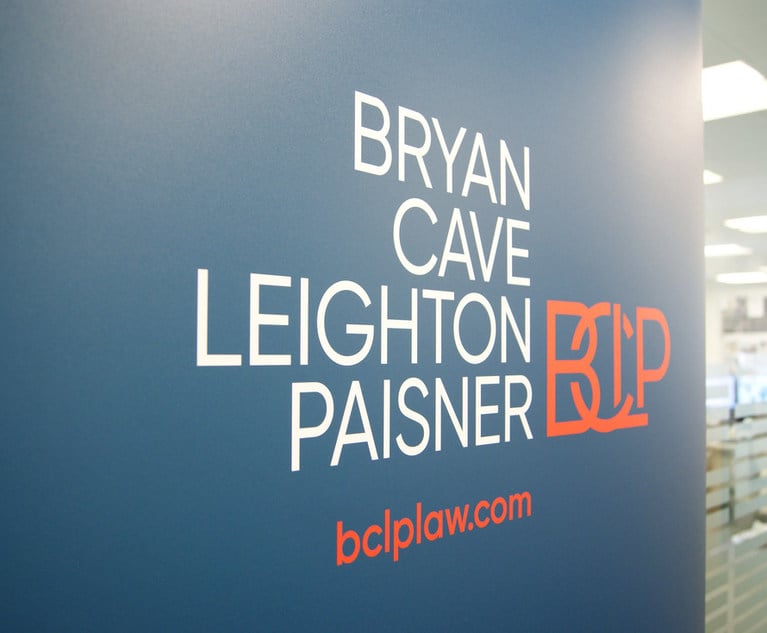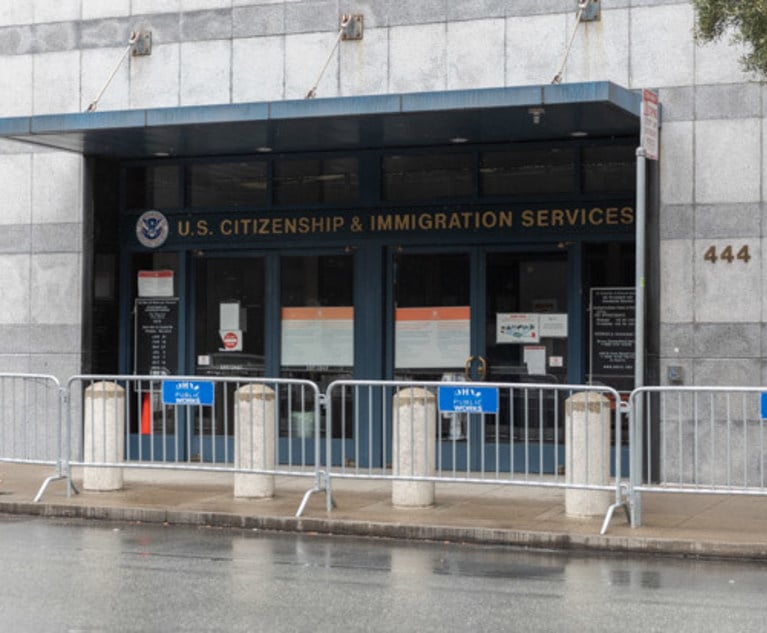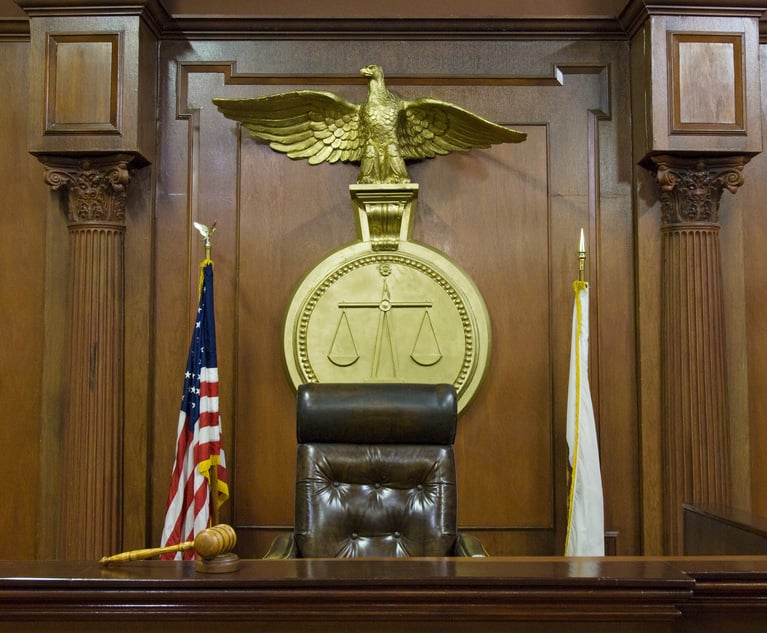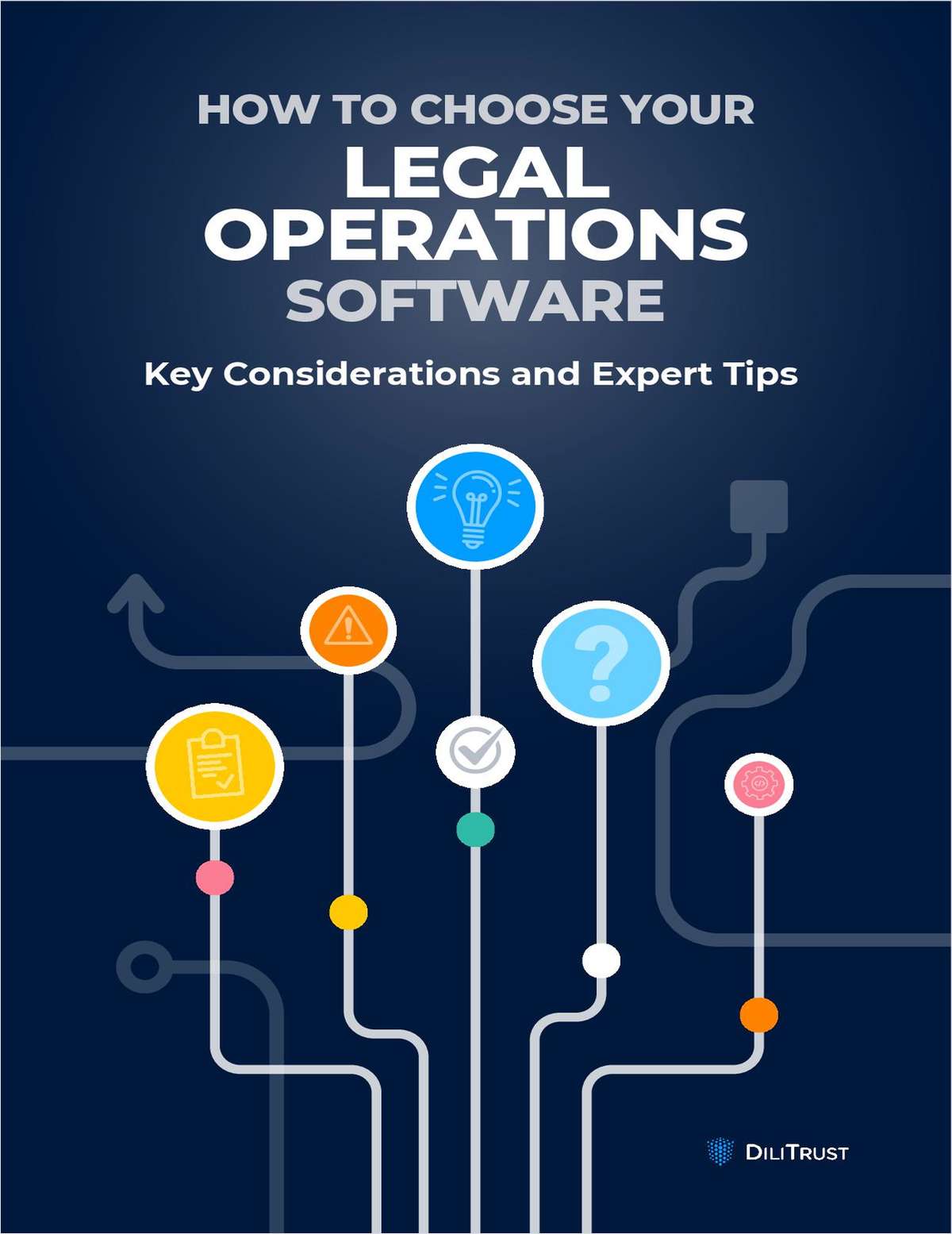 An empty podium at the U.S. Court of Appeals for the Ninth Circuit. (Photo: Jason Doiy/ALM)
An empty podium at the U.S. Court of Appeals for the Ninth Circuit. (Photo: Jason Doiy/ALM)Quiet Time? Oral Arguments Disappear in Federal Appeals Courts
The number and percentage of cases argued at the federal appellate level is fading leaving firms to ask where their next generation of appellate lawyers can turn for courtroom experience.
May 30, 2018 at 06:00 PM
9 minute read
The original version of this story was published on National Law Journal
Oral arguments before federal appellate panels are where marquee partners at the nation's top firms make their clients' cases, cement their reputations and earn their four-figure billing rates.
But with oral argument increasingly falling out of favor with most federal appellate courts, the opportunities to stand up in court and plead a case are lessening. The most recent year statistics available from the Administrative Office of the U.S. Courts—the 12-month period ending Sep., 30, 2017—had just 6,913 arguments out of the 34,561 appeals decided on the merits. That 20 percent is a far cry from the 27.3 percent of all cases a decade ago (8,662 arguments heard), and an even more steep decline from the 40.1 percent of cases (10,357 arguments heard) just 20 years ago—when oral argument data became available from the Administrative Office.
Reed Smith partner James Martin, who helped lead a study about the flagging number of arguments for the American Academy of Appellate Lawyers titled “Wither Oral Argument?”, concedes that preparing for argument eats into court time and resources. But, he said that “systemically oral argument is important” beyond its impact on the outcome of any given case.
“I think that there needs to be a recognition by advocates that not every case deserves argument,” said Martin, who is based in Pittsburgh and Los Angeles. “But there needs to be a concomitant recognition by the courts that more cases should be argued than not.”
Martin and other members of the AAAL's Oral Argument Initiative met with judges on eight of the country's circuit courts over the past few years and developed a set of recommendations for how the courts could “resurrect” the culture of oral argument. They transmitted their findings to U.S. Chief Justice John Roberts Jr. and the chief judges of the circuit courts last year.
“Oral argument is, after all, the only time where a party and its advocate can interact with the decision-maker,” the report said, going on to call oral argument “the most tangible manifestation of the critical role that appellate courts play in the resolution of public and private disputes traversing our legal system.”
The report then prescribes steps lawyers and courts can take to make arguments a more useful and regular part of federal appellate practice. Will the nudge from the nation's top appellate advocates spur courts to hear more arguments? Martin said he thinks that's “an open question.”
“You're not going to get any judge to say 'We don't need [argument],” Martin said. “But the percentages at some level speak to it themselves.”
|Why Not Argue?
Any judge or clerk will tell you that preparing for oral argument takes more time than deciding a case on the briefs. Time that judges and their clerks spend writing bench memos, testing potential questions, and, in some instances, traveling to distant courthouses to hear arguments, takes away from time to write opinions and dispose of cases.
In an op-ed in The New York Times last year, Judge William Pryor of the U.S. Court of Appeals for the Eleventh Circuit wrote that “hearing oral arguments and issuing published opinions in most [cases] would only delay decisions that should be speedy.” Pryor noted that although current caseloads are heavier than in the past, the nation's appeals courts have streamlined the way they make decisions. Circuit judges, he wrote, have technology that allows them to research and write opinions much faster than in the past and they have access to professional staff in addition to clerical support.
Pryor also pointed out a fact that might sting some appellate lawyers in private practice: “Fewer oral arguments mean lower attorneys' fees for litigants.”
But time and cost aren't the only reasons judges have cited for the decline in arguments. In an interview with National Law Journal affiliate law.com last year, Third Circuit Chief Judge D. Brooks Smith said federal courts had seen a “demonstrable decline” in caseloads and civil litigation since the Great Recession. Laurie Webb Daniel, the chair of Holland & Knight's national appellate team and leader of the firm's Atlanta litigation practice, said that the judges she spoke with as part of AAAL's oral argument initiative often said they declined to hear arguments because it didn't affect their cases' outcome.
“It may help to explain the case, help them write an opinion,” said Daniel in an interview with the Daily Report, another NLJ affiliate. “But in most cases, it doesn't really change their mind.”
|Making a Case for Oral Argument
Still, appellate litigators say that focusing on the lack of cases where arguments change outcomes misses some of the vital purposes it serves in the appellate system. Mary-Christine “M.C.” Sungaila, a partner in the Costa Mesa, California, office of Haynes and Boone, said that arguments are most important to the parties themselves. “As a party, honestly, that's the only part of the process you see,” she said. “People may not agree with the result, but it's important to make sure they feel they've had their day in court and feel they've been heard, if not agreed with.”
Bruce Merenstein, the chair of the appellate practice group at Schnader Harrison Segal & Lewis, based in Philadelphia, agreed. Oral arguments, he said, allow clients “to see that the court is taking their case seriously.” But Merenstein added that advocates' focus on arguments can sometimes outpace their overall importance.
“To be perfectly frank, it's not the primary part of being an appellate lawyer,” Merenstein said, pointing to all the time he spends developing legal arguments, researching, deciding which issues to raise on appeal, and drafting briefs. “That's where most cases are won or lost.”
Still, other advocates point out that oral argument's effect can be corrective if not determinative. “Sometimes judges have a mistaken notion about what's actually happened in that case,” said Alan Morrison, the former director of the Public Citizen Litigation Group. “In oral argument, you get a last chance to correct that,” said Morrison, now the Lerner Family Associate Dean for Public Interest and Public Service Law at The George Washington University Law School.
Morrison said that the time preparing for argument and engaging with advocates without the distraction of computers or phones causes judges to focus in ways that they otherwise wouldn't. “Things happen to people who are sitting there,” Morrison said. “If that helps them learn better it's useful.”
Morrison handled the number crunching for the AAAL's project. He cautions that the raw numbers don't tell the whole story since many of the cases that aren't argued involve pro se criminal defendants, prisoner cases or immigration appeals where precedent clearly directs the outcome. “If you have a pro se case, you shouldn't look at it as the same thing as an EPA regulation case,” he said.
But even after factoring appeals that have been consolidated, according to Morrison's numbers there are wide variations from circuit-to-circuit. Only the D.C. Circuit and the Seventh Circuit hear anywhere near half of all competitive cases—45 and 55 percent respectively. The Third, Fourth, and Eleventh Circuits, meanwhile, hear arguments in less than 15 percent of cases.
The lack of argument, Morrison said, means that “we're losing the opportunities to train the next generation of oral advocates.”
Some in the circuit courts themselves have acknowledged that problem and have sought to create opportunities for newly minted lawyers to handle appeals. Haynes and Boone's Sungaila helped head up an American Bar Association litigation section subcommittee that put together a comprehensive guide to the pro bono opportunities available at each of the circuit courts—opportunities that often lead to the chance to argue. While larger circuits tend to have highly organized and competitive processes for choosing pro bono counsel in certain cases, some smaller circuits keep informal lists of individual lawyers and firms who have reached out by letter to the chief judge to express interest in helping out pro bono when needed.
Sungaila's home circuit, the Ninth Circuit, refers cases to pro bono counsel in immigration and pro se matters that staff lawyers and judges flag as presenting significant legal issues. “They're not saying they're winners, but they do identify that this has a meaty issue and that 'We would benefit from having counsel on both sides,'” Sungaila said.
Sungaila, who also teaches a Loyola Law School appellate clinic, singled out a Ninth Circuit program that allows student law clinics to handle pro bono appeals. She said her students at Loyola argued at the same April session as those from University of Nevada, Las Vegas and University of California, Irvine clinics. Such programs, she admits, require a “pretty robust effort on the staff attorney side” that smaller circuits might not be able to invest.
Reed Smith's Martin said that adopting such pro bono initiatives is just one of the proposals that the AAAL has suggested could boost the number and quality of arguments. The group's report also encourages courts to embrace technology where appropriate to let lawyers and judges appear remotely and to use focus letters pre-argument to point the parties to the issues that would benefit from argument.
At the same time, Martin said that the onus is also on practitioners to make argument worthwhile for judges.
“The quality of the advocacy has to improve. That's a place where of course appellate lawyers have a role to play,” Martin said. “If we can raise the quality of the oral advocacy, I think the courts will be much more willing to engage.”
”We have to understand always that while we're users of the system it has to work for the people who are deciding cases.”
This content has been archived. It is available through our partners, LexisNexis® and Bloomberg Law.
To view this content, please continue to their sites.
Not a Lexis Subscriber?
Subscribe Now
Not a Bloomberg Law Subscriber?
Subscribe Now
NOT FOR REPRINT
© 2024 ALM Global, LLC, All Rights Reserved. Request academic re-use from www.copyright.com. All other uses, submit a request to [email protected]. For more information visit Asset & Logo Licensing.
You Might Like
View All
Trump and Latin America: Lawyers Brace for US's Hardline Approach to Region

BCLP Exploring Merger Prospects as Profitability Lags, Partnership Shrinks

Anticipating a New Era of 'Extreme Vetting,' Big Law Immigration Attys Prep for Demand Surge
6 minute read
Democratic State AGs Revel in Role as Last Line of Defense Against Trump Agenda
7 minute readTrending Stories
- 1Judge Denies Sean Combs Third Bail Bid, Citing Community Safety
- 2Republican FTC Commissioner: 'The Time for Rulemaking by the Biden-Harris FTC Is Over'
- 3NY Appellate Panel Cites Student's Disciplinary History While Sending Negligence Claim Against School District to Trial
- 4A Meta DIG and Its Nvidia Implications
- 5Deception or Coercion? California Supreme Court Grants Review in Jailhouse Confession Case
Who Got The Work
Michael G. Bongiorno, Andrew Scott Dulberg and Elizabeth E. Driscoll from Wilmer Cutler Pickering Hale and Dorr have stepped in to represent Symbotic Inc., an A.I.-enabled technology platform that focuses on increasing supply chain efficiency, and other defendants in a pending shareholder derivative lawsuit. The case, filed Oct. 2 in Massachusetts District Court by the Brown Law Firm on behalf of Stephen Austen, accuses certain officers and directors of misleading investors in regard to Symbotic's potential for margin growth by failing to disclose that the company was not equipped to timely deploy its systems or manage expenses through project delays. The case, assigned to U.S. District Judge Nathaniel M. Gorton, is 1:24-cv-12522, Austen v. Cohen et al.
Who Got The Work
Edmund Polubinski and Marie Killmond of Davis Polk & Wardwell have entered appearances for data platform software development company MongoDB and other defendants in a pending shareholder derivative lawsuit. The action, filed Oct. 7 in New York Southern District Court by the Brown Law Firm, accuses the company's directors and/or officers of falsely expressing confidence in the company’s restructuring of its sales incentive plan and downplaying the severity of decreases in its upfront commitments. The case is 1:24-cv-07594, Roy v. Ittycheria et al.
Who Got The Work
Amy O. Bruchs and Kurt F. Ellison of Michael Best & Friedrich have entered appearances for Epic Systems Corp. in a pending employment discrimination lawsuit. The suit was filed Sept. 7 in Wisconsin Western District Court by Levine Eisberner LLC and Siri & Glimstad on behalf of a project manager who claims that he was wrongfully terminated after applying for a religious exemption to the defendant's COVID-19 vaccine mandate. The case, assigned to U.S. Magistrate Judge Anita Marie Boor, is 3:24-cv-00630, Secker, Nathan v. Epic Systems Corporation.
Who Got The Work
David X. Sullivan, Thomas J. Finn and Gregory A. Hall from McCarter & English have entered appearances for Sunrun Installation Services in a pending civil rights lawsuit. The complaint was filed Sept. 4 in Connecticut District Court by attorney Robert M. Berke on behalf of former employee George Edward Steins, who was arrested and charged with employing an unregistered home improvement salesperson. The complaint alleges that had Sunrun informed the Connecticut Department of Consumer Protection that the plaintiff's employment had ended in 2017 and that he no longer held Sunrun's home improvement contractor license, he would not have been hit with charges, which were dismissed in May 2024. The case, assigned to U.S. District Judge Jeffrey A. Meyer, is 3:24-cv-01423, Steins v. Sunrun, Inc. et al.
Who Got The Work
Greenberg Traurig shareholder Joshua L. Raskin has entered an appearance for boohoo.com UK Ltd. in a pending patent infringement lawsuit. The suit, filed Sept. 3 in Texas Eastern District Court by Rozier Hardt McDonough on behalf of Alto Dynamics, asserts five patents related to an online shopping platform. The case, assigned to U.S. District Judge Rodney Gilstrap, is 2:24-cv-00719, Alto Dynamics, LLC v. boohoo.com UK Limited.
Featured Firms
Law Offices of Gary Martin Hays & Associates, P.C.
(470) 294-1674
Law Offices of Mark E. Salomone
(857) 444-6468
Smith & Hassler
(713) 739-1250








